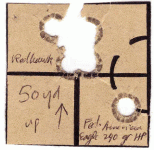Remington and Winchester only make one large pistol primer they claim works both for standard and magnum loads, and they seem to perform both tasks just fine. I assume they are somewhere inbetween what other makers offer as standard and magnum, but have never done testing to prove that one way or the other. If you are using primers from a maker that offers them separately, the magnum primer is likely to produce better velocity consistency and reduce the chance of having a squib load, but don't take that as gospel. Instead, check over the chronograph for velocity and SD differences. The primer whose loads produce an SD that is a smaller percentage of its mean velocity indicates you are getting best ignition consistency from it and should use that primer. Don't assume the choice will be the same in any other brand without re-testing.
Mississippi,
The velocity is about right, and the DW lets you tune the barrel/cylinder gap where you want it, which can help a little bit. Below is a 50 yard Redhawk group fired off bags. That was shot without reaming the chambers uniform, and the low and right hole appeared in every group and always from the tightest chamber throat. I was not using iron sights, though. A 1.5X pistol scope. The ammo was an old American Eagle JHP load which had the equivalent of 24 grains of 296/H110.

At one time, 24 grains for 240 grain JSP/JHP bullets was the one-and-only load recommendation Winchester made for 296. No starting load. It's that way in their 2003 data book, showing 1430 fps from a 6.5" test gun barrel length, so right in your ballpark and well-within normal gun-to-gun variability. The Winchester data gives 25 grains for 240 grain LSWC in one of the few published examples I've seen of a lead bullet load data being hotter and faster (1560 fps) than its jacketed counterpart. I've never seen any indication this data was unsafe in anything.
P.S., Note the Winchester velocity would have been measured at 15 ft, the SAAMI standard screen mid-point distance for muzzle velocity. For the Nosler 240 grain JHP, ballistics software predicts a 6 ft/s difference.

